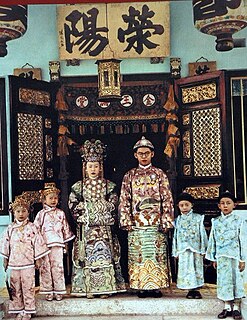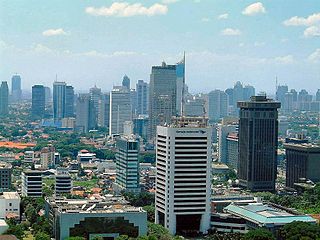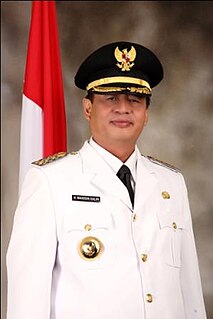Udaya Halim (born on March 26, 1953) is an Indonesian businessman and heritage activist of Benteng Chinese roots. [1] [2] [3] He is best known as the founder of the Benteng Heritage Museum in Tangerang, Indonesia. [1] [2]

Benteng Chinese are a Chinese-Indonesian community of 'Peranakan' or mixed descent, native to the historic Tangerang area in the modern-day Indonesian provinces of Jakarta, Banten and West Java.
The Benteng Heritage Museum is a heritage site and museum in Pasar Lama, the old market district in Tangerang, Banten, Indonesia. Located near the river Cisadane, it is the first Indonesian museum that highlights the history and heritage of ethnic Chinese in Indonesia.

Tangerang is a city in the province of Banten, Indonesia. Located on the western border of Jakarta, it is the third largest urban centre in the Greater Jakarta metropolitan area after Jakarta and Bekasi; the sixth largest city proper in the nation; and the largest city in Banten province. It has an area of 164.54 square kilometres and an official 2010 Census population of 1,797,715, increasing to 2,001,925 as at 2014 – making it the eighth most populated suburb in the world at the latter date.
Halim grew up in Tangerang's historic Pasar Lama area. [1] In 1997, during the Asian economic crisis, he moved with his family to Perth, Western Australia. [1] Halim acquired the historic building that now houses the Benteng Heritage Museum in 2009. [2] Following extensive restoration and conservation work, the Benteng Heritage Museum was officially unveiled on November 11, 2011. [2]

Perth is the capital and largest city of the Australian state of Western Australia. It is named after the city of Perth, Scotland and is the fourth-most populous city in Australia, with a population of 2.04 million living in Greater Perth. Perth is part of the South West Land Division of Western Australia, with the majority of the metropolitan area located on the Swan Coastal Plain, a narrow strip between the Indian Ocean and the Darling Scarp. The first areas settled were on the Swan River at Guildford, with the city's central business district and port (Fremantle) both later founded downriver.

Western Australia is a state occupying the entire western third of Australia. It is bounded by the Indian Ocean to the north and west, and the Southern Ocean to the south, the Northern Territory to the north-east, and South Australia to the south-east. Western Australia is Australia's largest state, with a total land area of 2,529,875 square kilometres, and the second-largest country subdivision in the world, surpassed only by Russia's Sakha Republic. The state has about 2.6 million inhabitants – around 11 percent of the national total – of whom the vast majority live in the south-west corner, 79 per cent of the population living in the Perth area, leaving the remainder of the state sparsely populated.








